Porsche News
Moderator
- Joined
- 8 Feb 2008
- Messages
- 7,361
by www.Edmunds.com
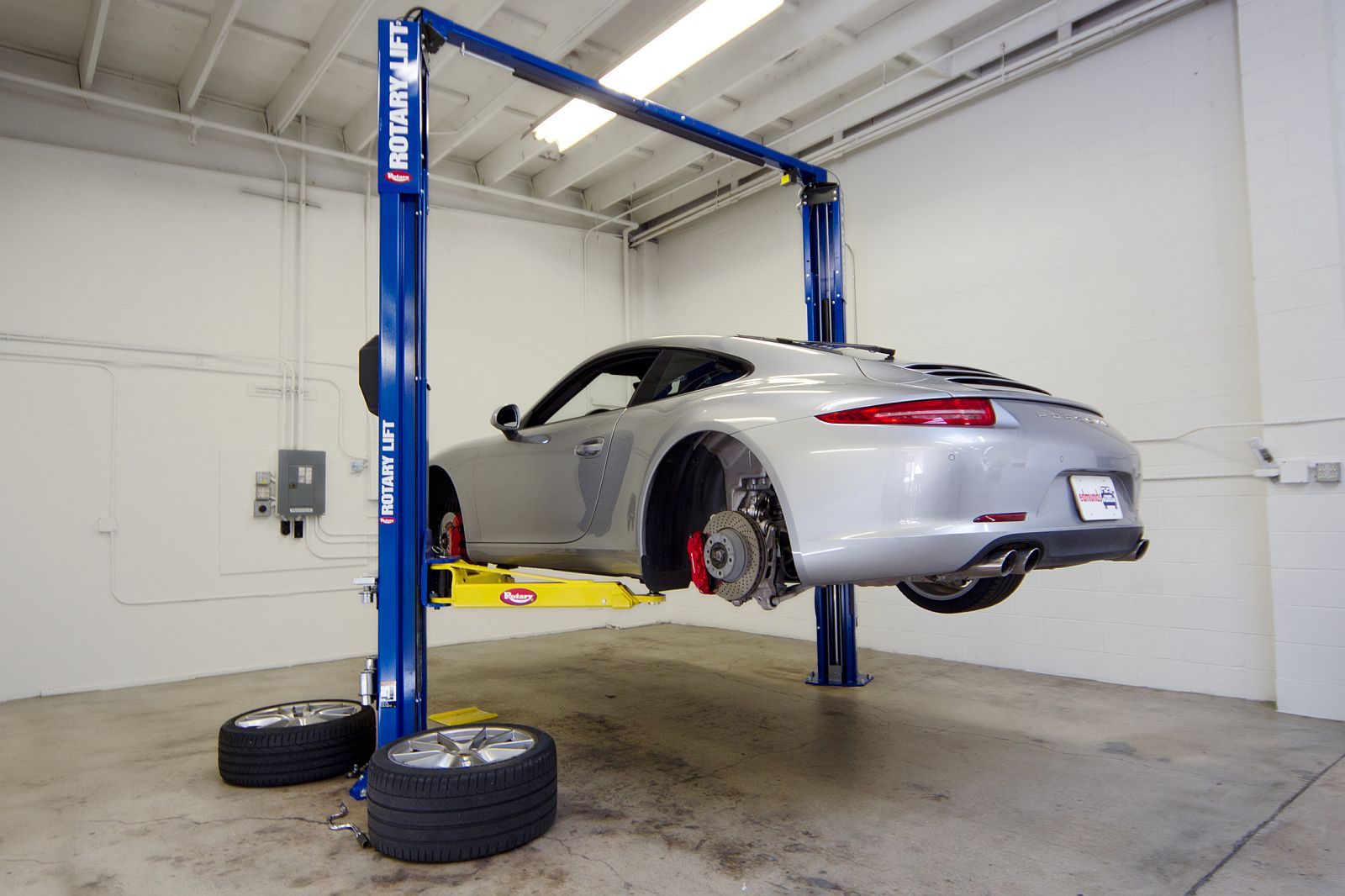
We thrashed the new 2012 Porsche 911 Carrera S at the track and then we tossed it at some curvaceous mountain roads. Now it's time to give the 911 a much-needed rest and hoist it up on our new Rotary two-post lift for a clear look at the suspension that does the business.
This new 911 is in fact a 991 in the language of Porsche engineering, which is why the 991 prefix appears on the various components we'll soon see. You may also notice a bit of grit and grime under there because the roads were wet much of the time we had it -- except at the track, thank goodness.
Let's get on with it. Here's the 411 on the new 911 suspension.
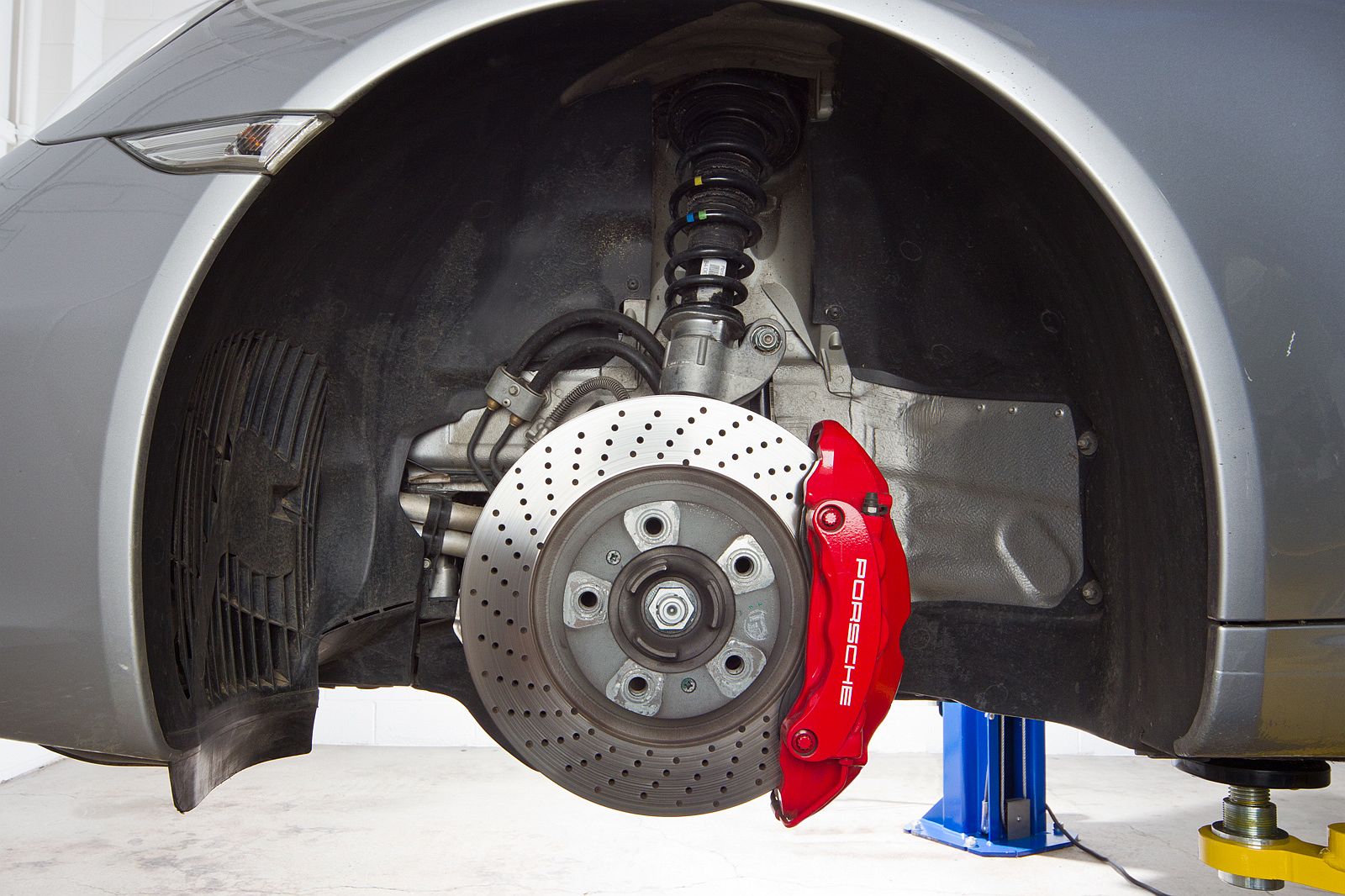
From here we see what looks like the standard 911 setup: humungous brakes and a MacPherson strut suspension.
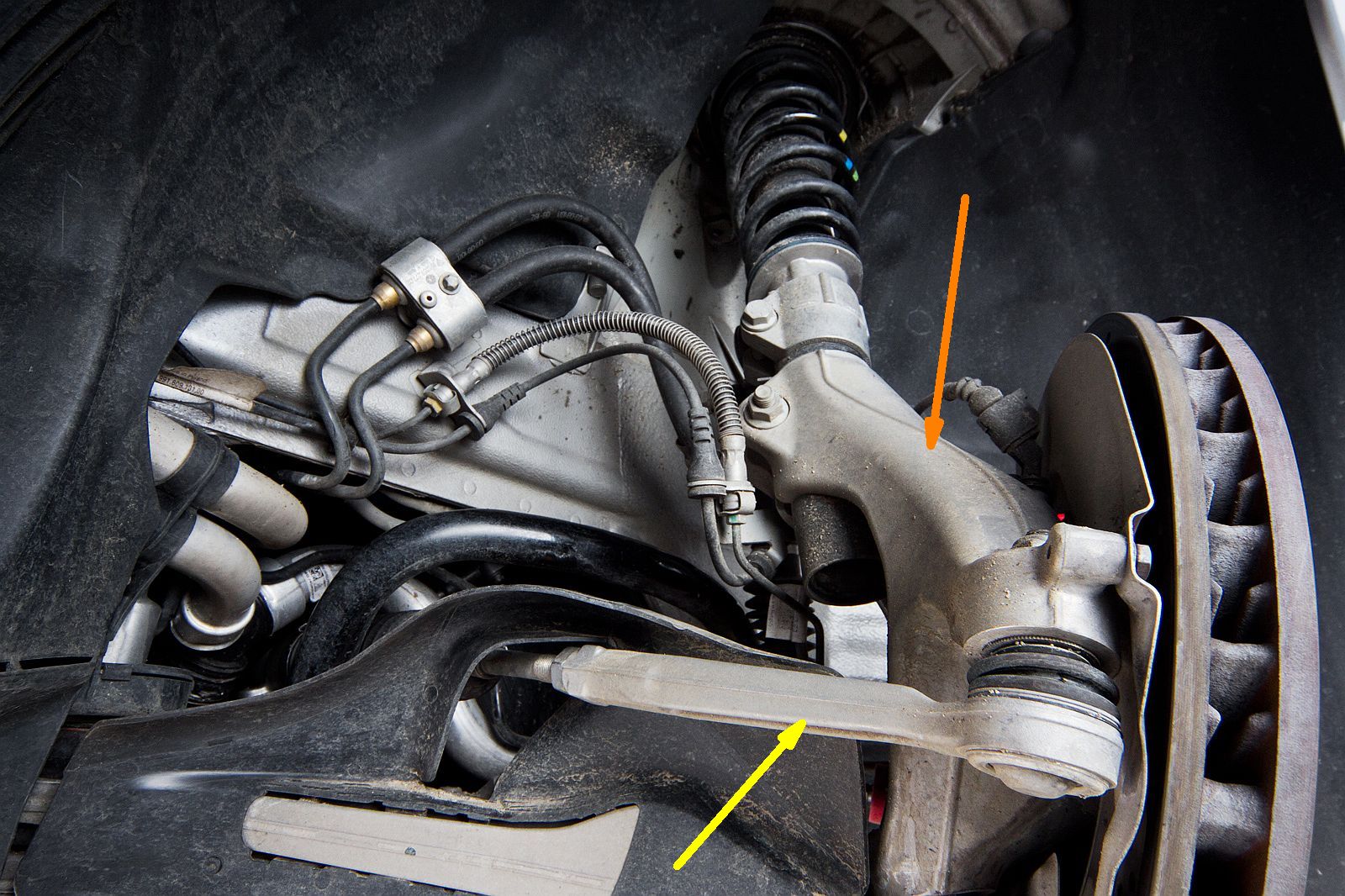
A forged aluminum front knuckle (orange) grasps the bottom of the coil-over strut. Like other 911s before it, the 991's steering (yellow) meets it up ahead of the front axle's centerline.
It's electric power steering this time out, but the components are buried beneath covers we don't dare remove. Steering feel earned mixed reviews, but steering accuracy and direct response are as good or better than what we've found in the model it replaces.
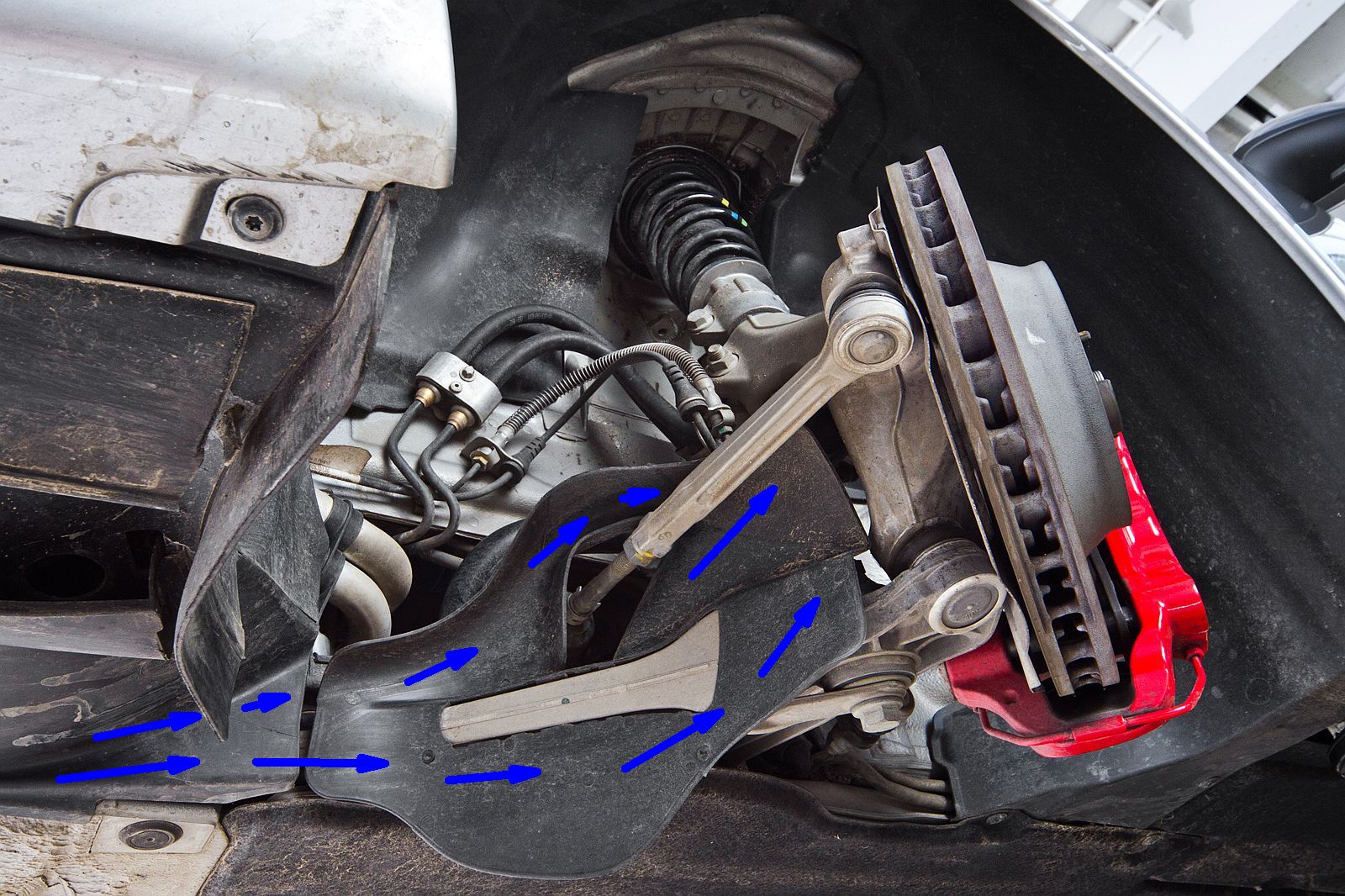
The lower control arm is partially hidden by a convoluted bit of ductwork that sends cooling, soothing relief to the brakes.
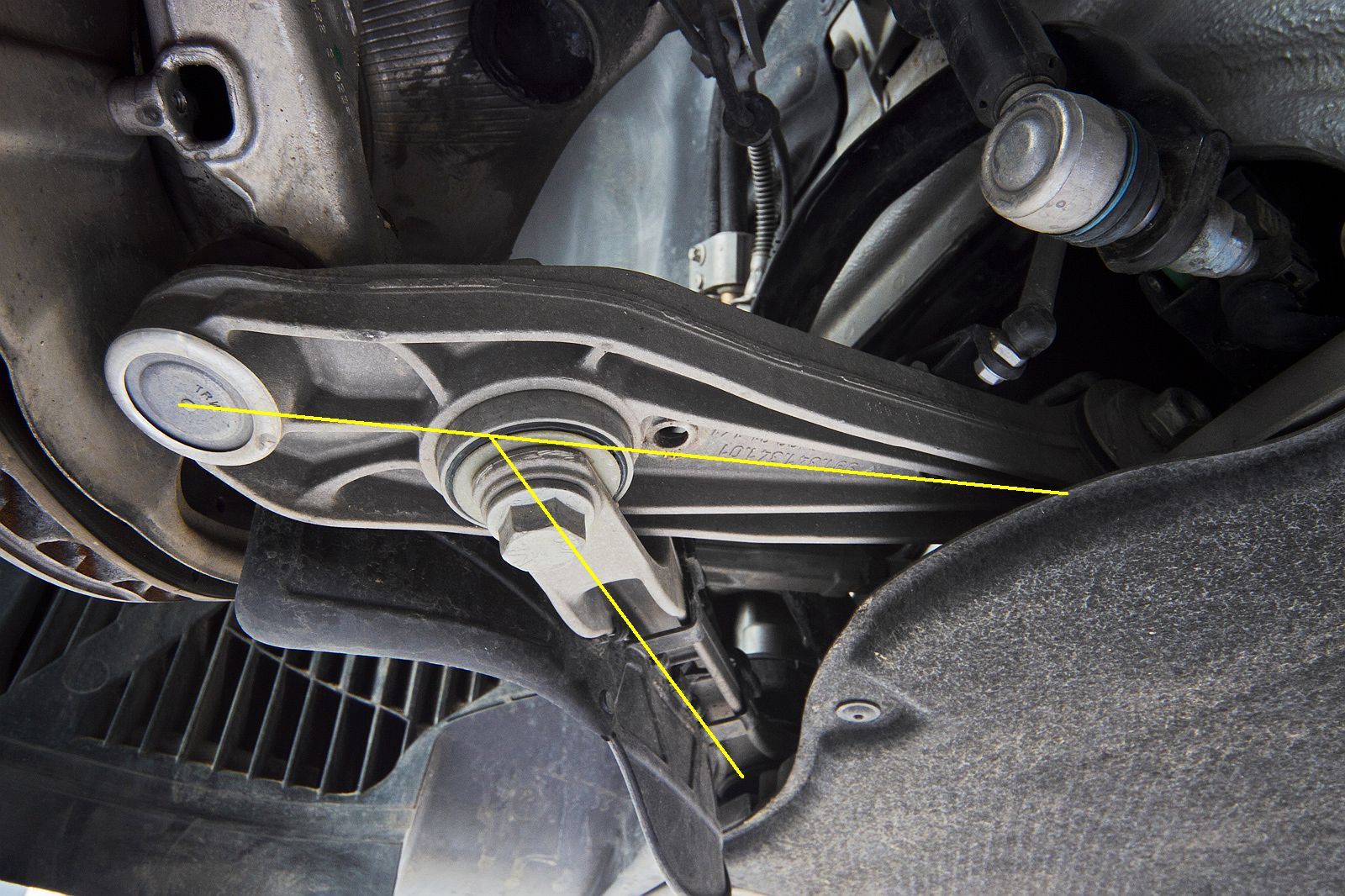
A lateral link and a tension link come together in a bolted joint to make that lower control arm. Forged aluminum, of course.
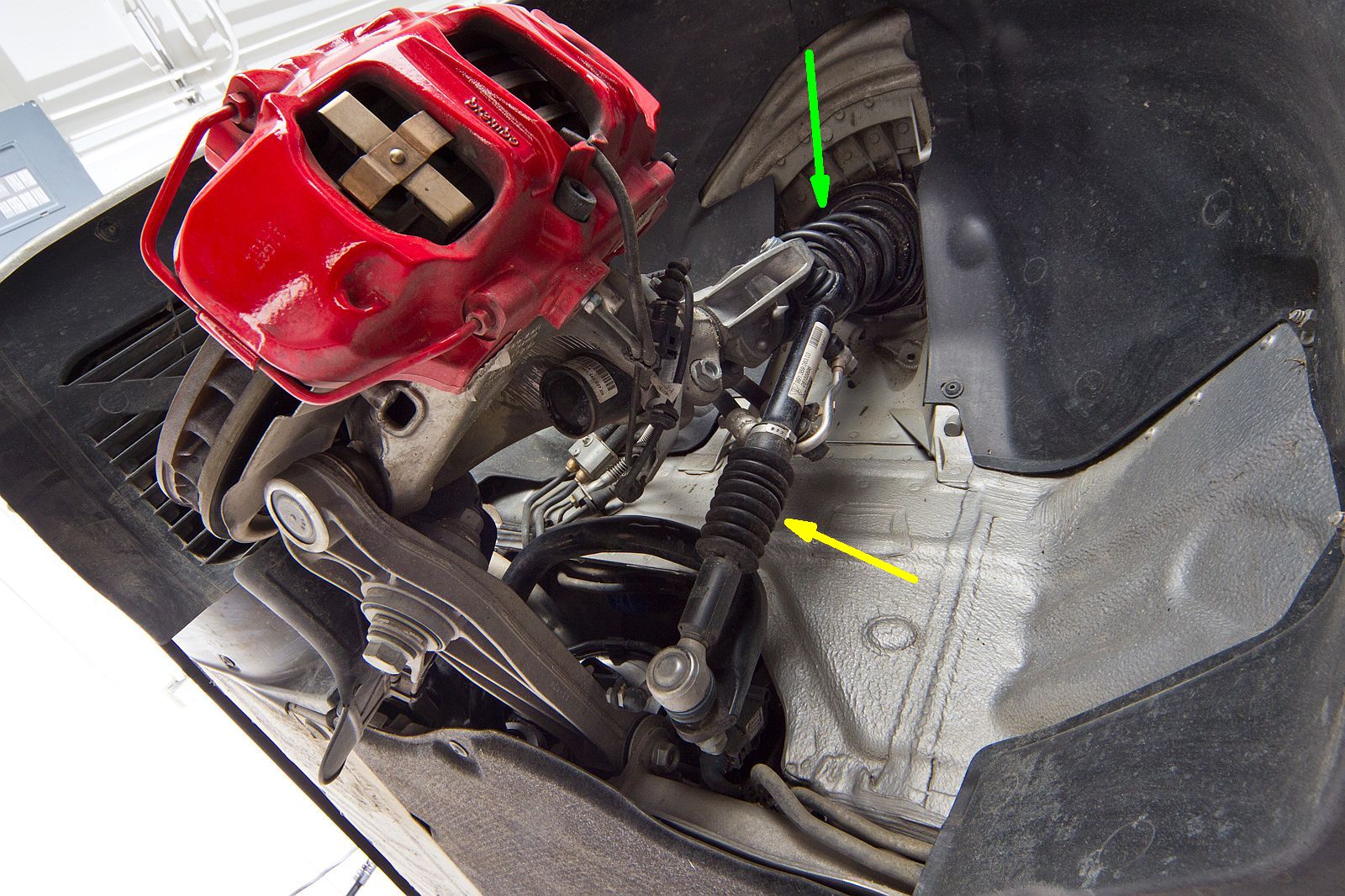
As we've seen before, the front stabilizer bar loops over the top of the lower control arm to meet up with the stabilizer link (yellow,) but here that link is something very special, indeed.
Meanwhile, the damper within the strut housing is fitted with PASM (Porsche Active Stability Management,) a continuously variable damping system with two driver-selectable operating ranges, Normal and Sport.
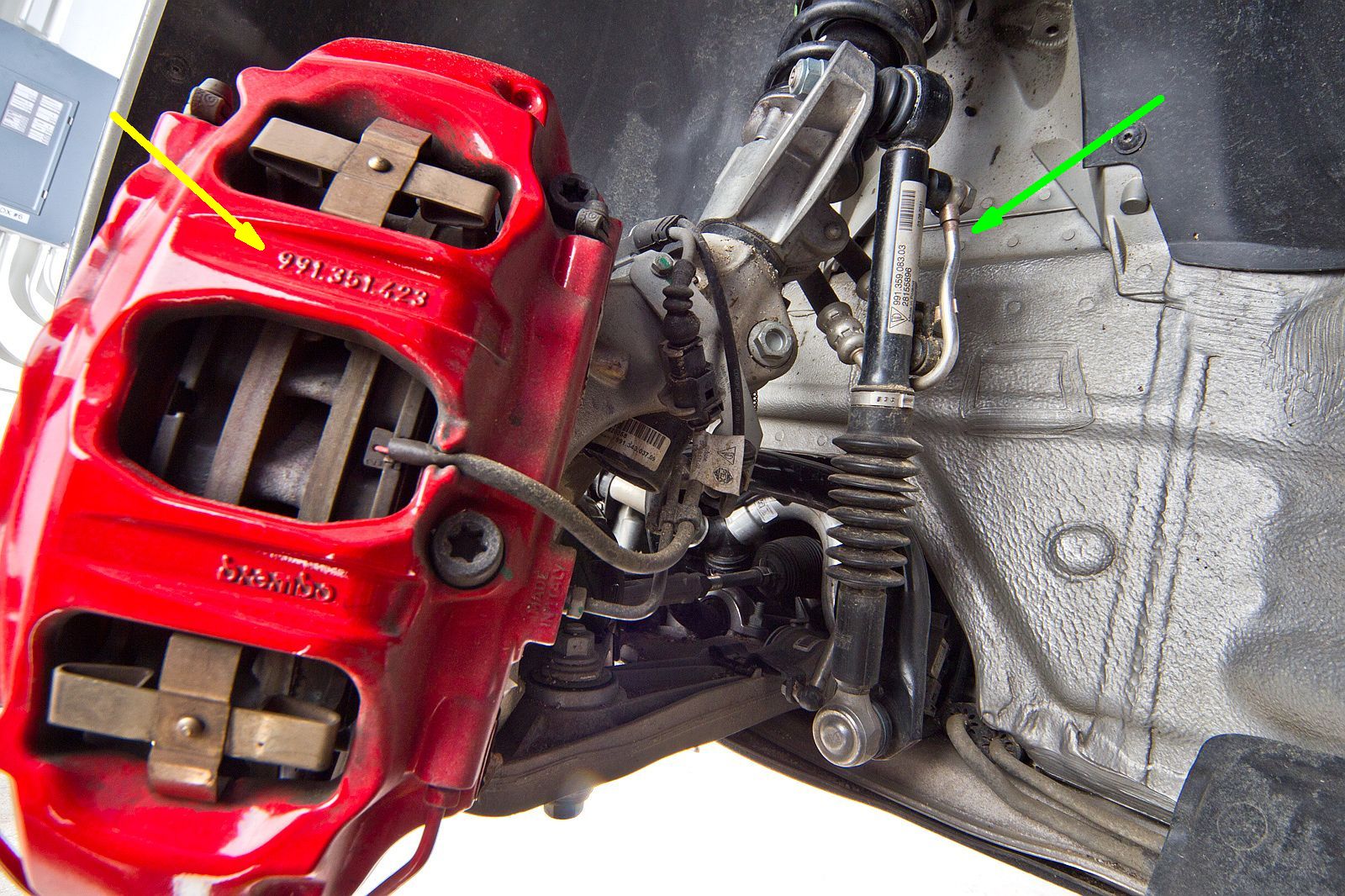
The stabilizer bar link (green) is hydraulic, as is its opposite number on the other side of the car. A central computer looks at body height sensors, steering angle and a host of other factors to determine how to make them behave.
On straight roads they can go limp to essentially remove the stabilizer bar from the picture for a smooth ride. In corners they can be made to "overdrive" what the stabilizer bar could otherwise do on its own to utterly eliminate body roll. Or the computer can dial in any amount of roll stiffness in between, and it can change its mind in real time as road conditions or driver inputs fluctuate.
Porsche calls this Porsche Dynamic Chassis Control (PDCC) and it's the first time they've fit it to a 911-series vehicle. Whatever you call it, it flat works. This very car pulled 1.04 g on our skidpad, and some of the credit has to be put down to the way this system can make use of all four tires instead of leaning heavily on the outside ones.
You could theoretically achieve the same skidpad prowess with a pair of very big stabilizer bars, but then the car would ride like Grade A dog doo. Conversely, a hydraulic anti-roll system such as this doesn't need a physical stabilizer in between the left and right struts at all, but in that case there'd be no fail-safe if the system developed a fault.
As for those looming red brakes, the massive 6-piston Brembo calipers have a pair of fixed bridges (yellow) for maximum caliper stiffness. This means the calipers have to come off when it's time to change the brake pads which, incidentally, are equipped with electronic pad wear sensors.
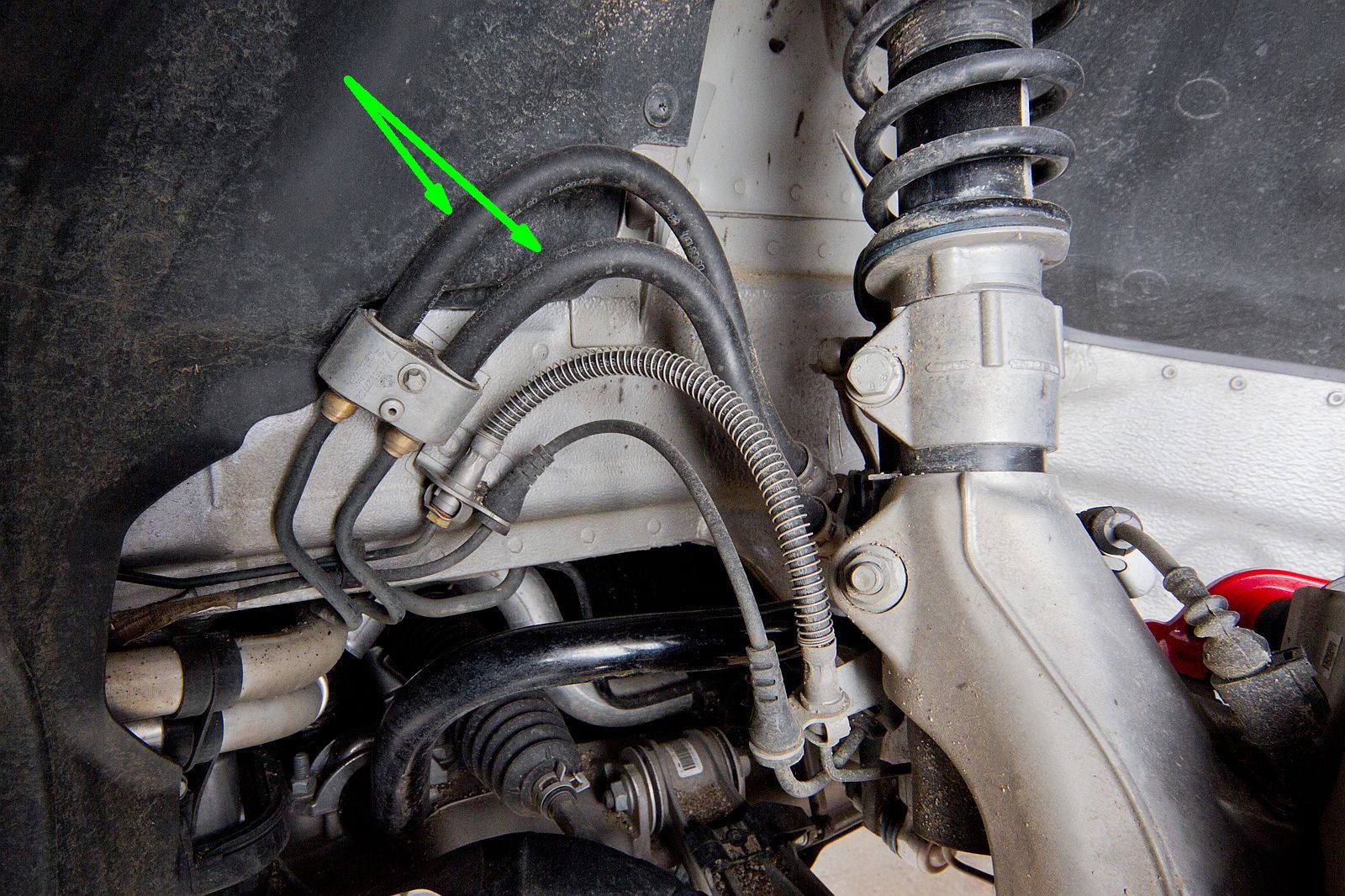
And now we know what these big hoses (green) are for: they feed hydraulic fluid to the PDCC active stabilizer bar struts.
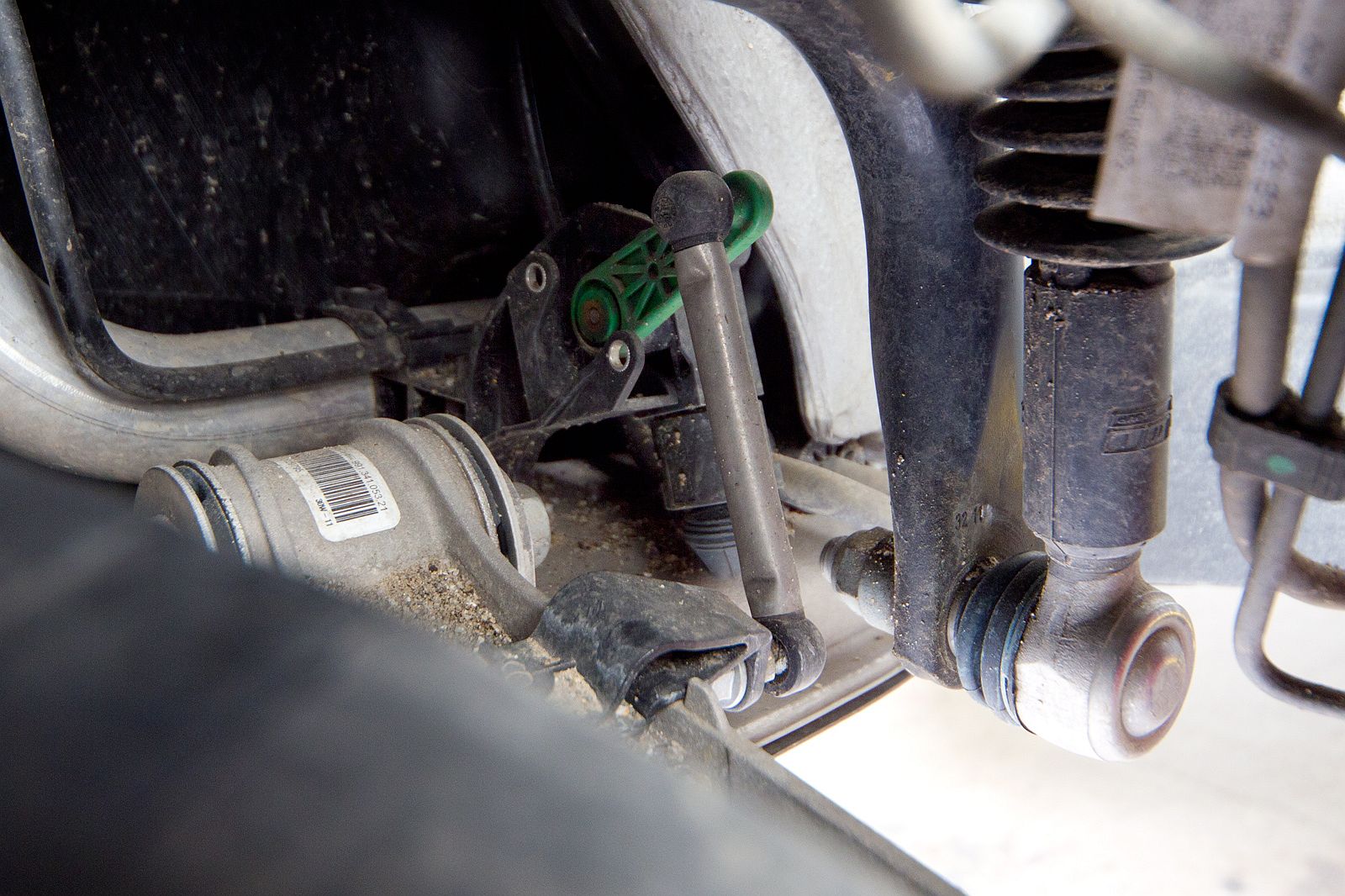
This sensor, along with three more at the other suspension corners, measures the position of the lower control arm to deduce the position of the tire.
The PDCC system compares the readings to that generated on the other side to measure body roll, and the PASM active damping system uses them to understand the motions of the wheels in order to determine the amount of damping required, be it for ride, cornering, dive/squat, etc. It's likely the headlights use 'em too for auto-leveling.
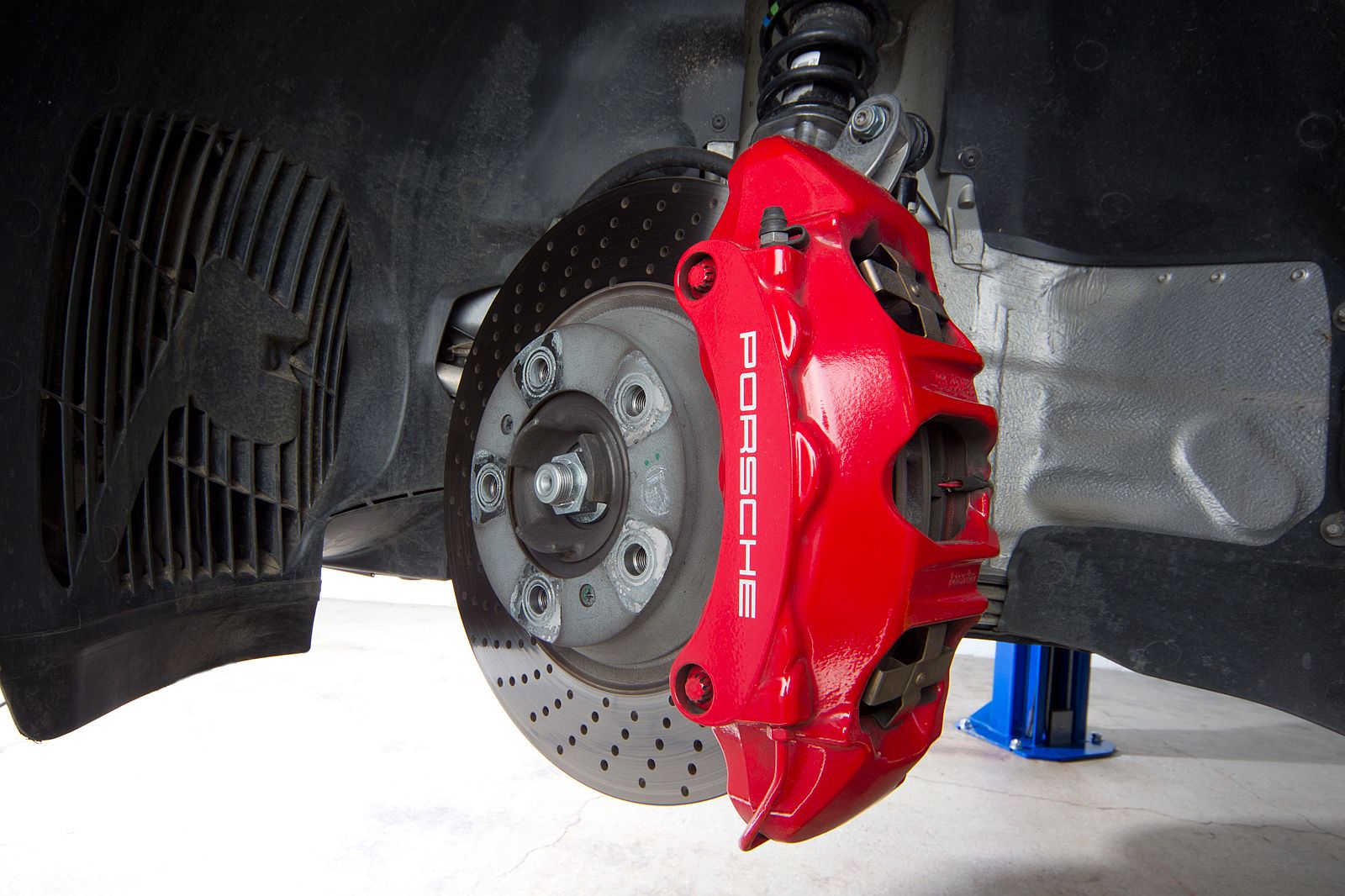
Here's another look at the 6-piston Brembo calipers. The ventilated and drilled rotors they grip are 13.4 inches in diameter and 1.3 inches thick. This car stopped from 60 mph in 102 feet.
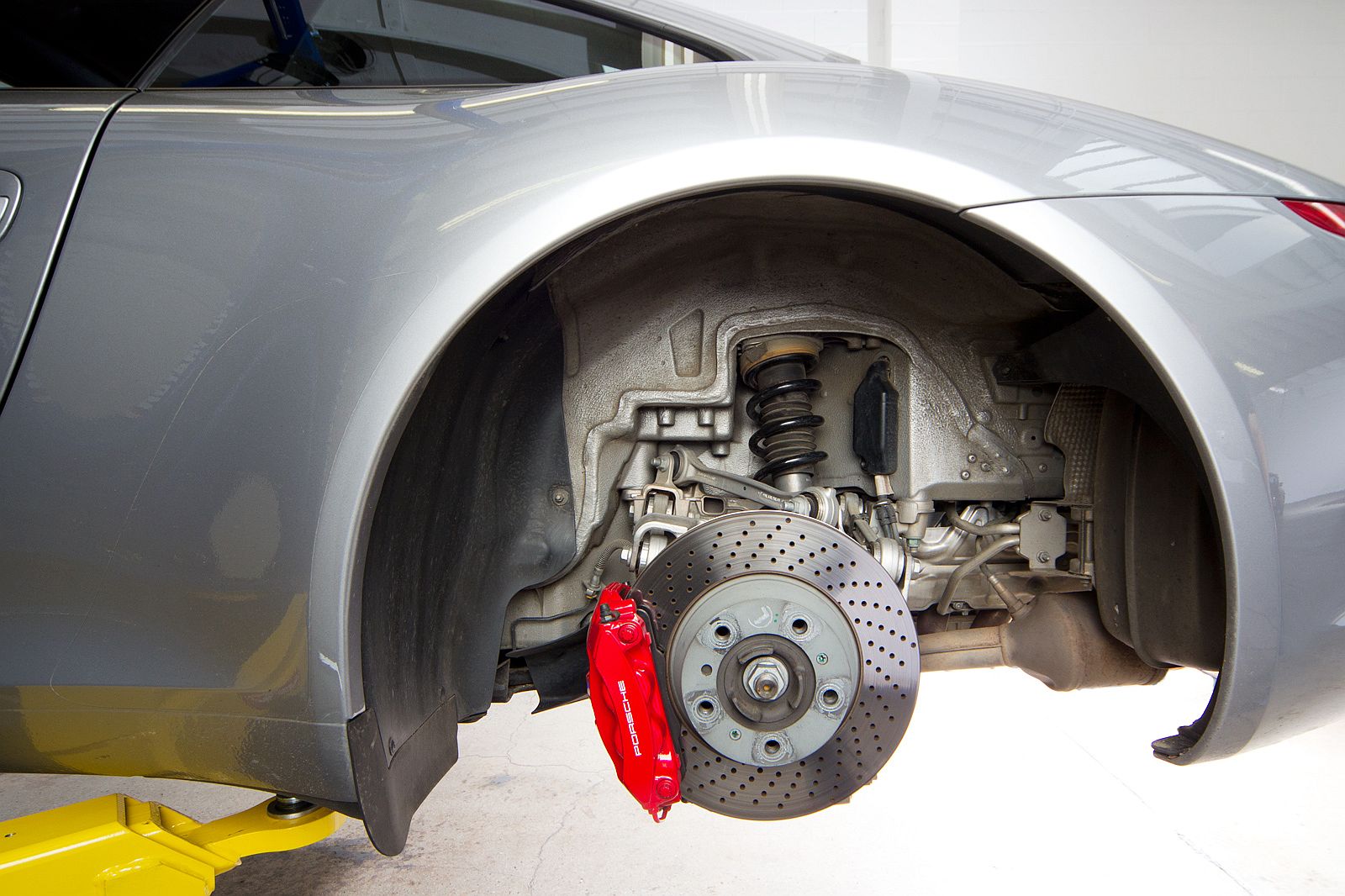
Out back we find a new beautiful-looking multilink suspension.
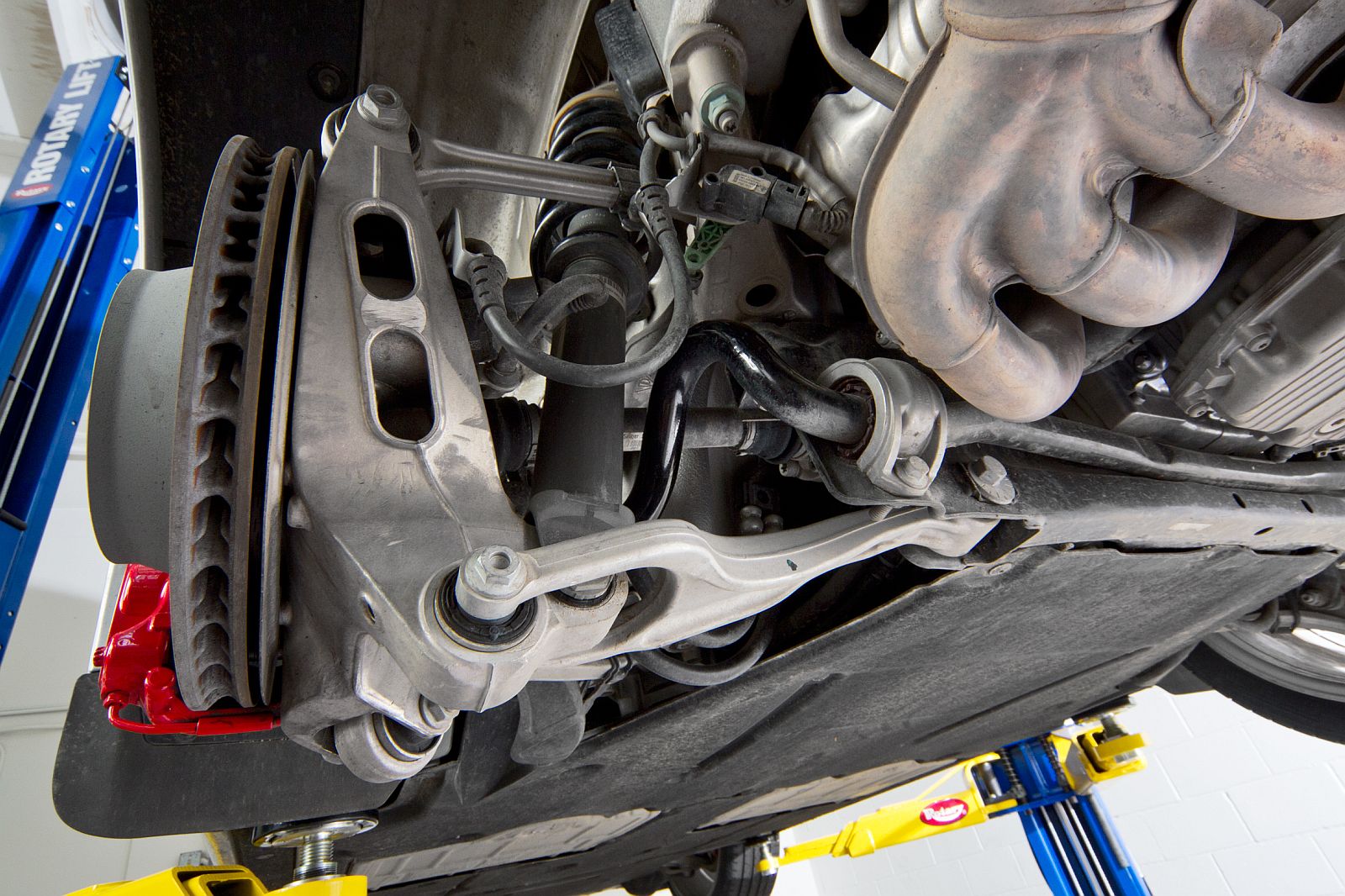
A sea of forged aluminum surrounds a coil-over monotube shock that naturally contains the same PASM damping internals found up front.
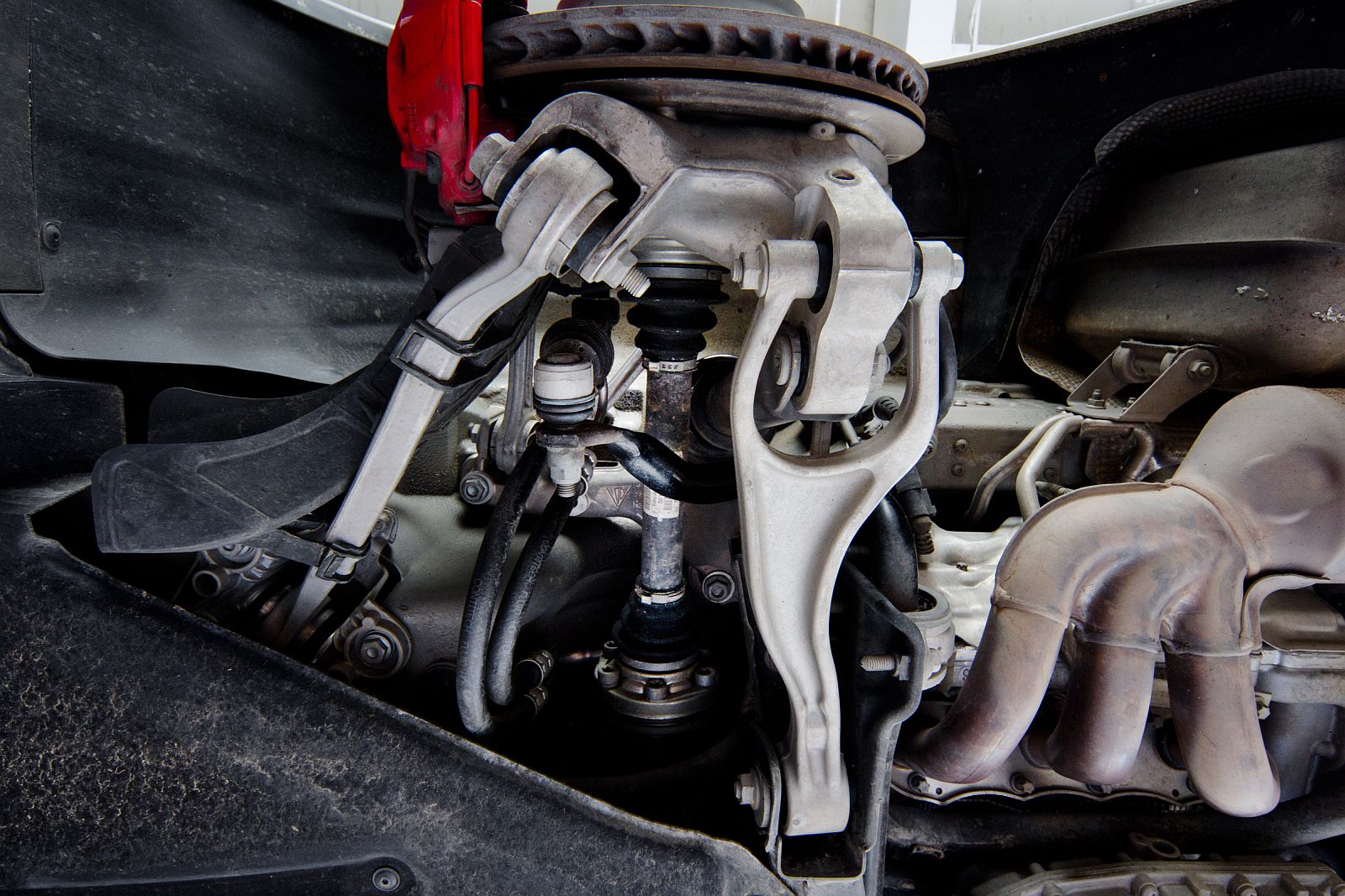
Our new Rotary lift makes it easy to get directly under the car to get a clear view of the 991's two lower links.
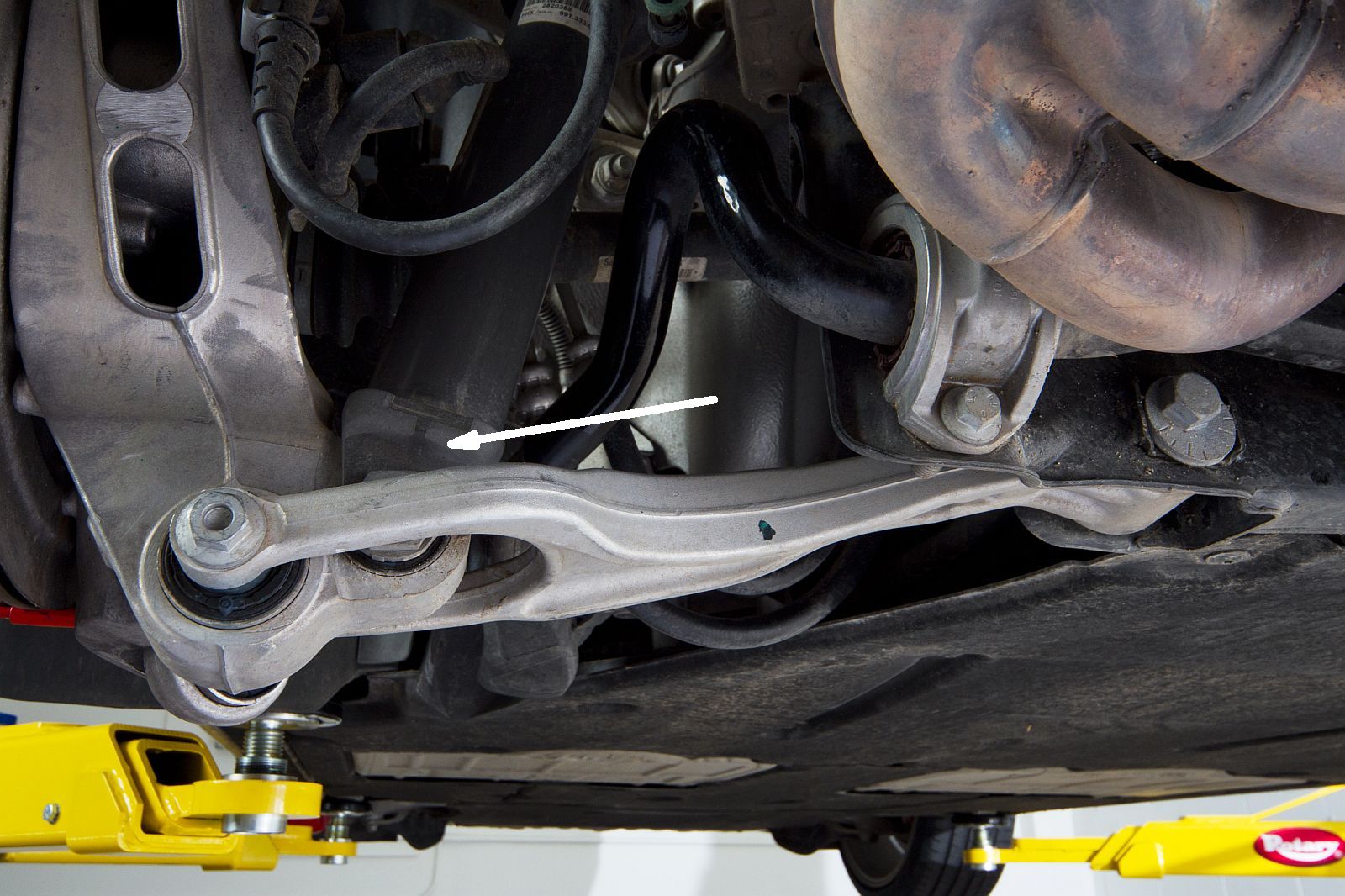
The rear shock (and the spring that surrounds it) attaches directly to the rear knuckle for a 1-to-1 motion ratio. Such a ratio demands a long shock absorber, so the lower link employs a fork shape to allow the shock to sit low in the car.
Camber adjustments are made via an eccentric cam on this link's inner end.
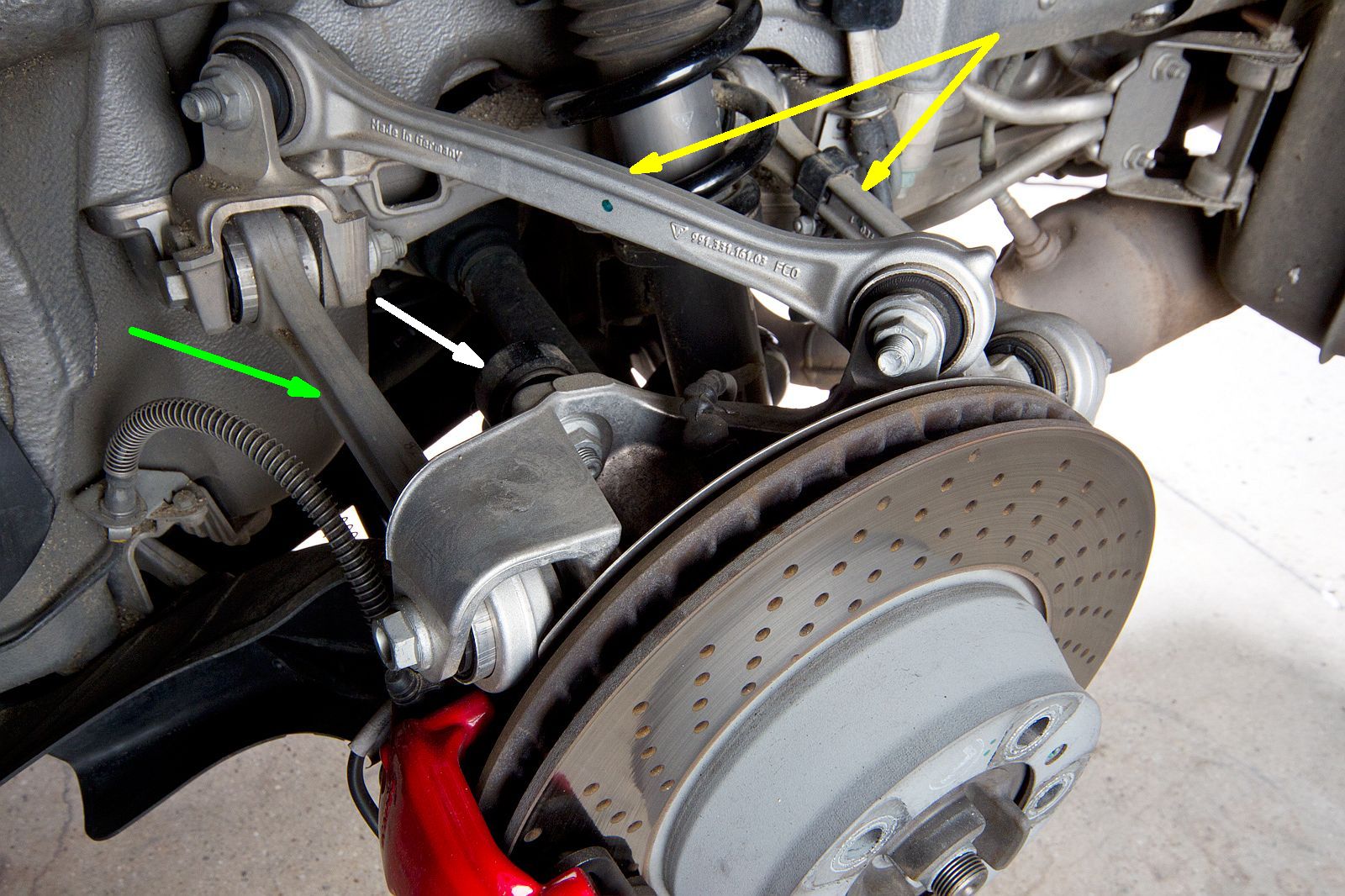
Think of the rearmost pair of upper links (yellow) as an approximation of an upper control arm and the forward link (green) as a toe link. Close as they are to the hot brake rotor, their outboard pivot bushings must be made of hardy stuff.
The top of the rear stabilizer bar link (white) is just barely in view, but the fact that it's mounted directly to the rear knuckle means it operates at a 1-to-1 motion ratio.
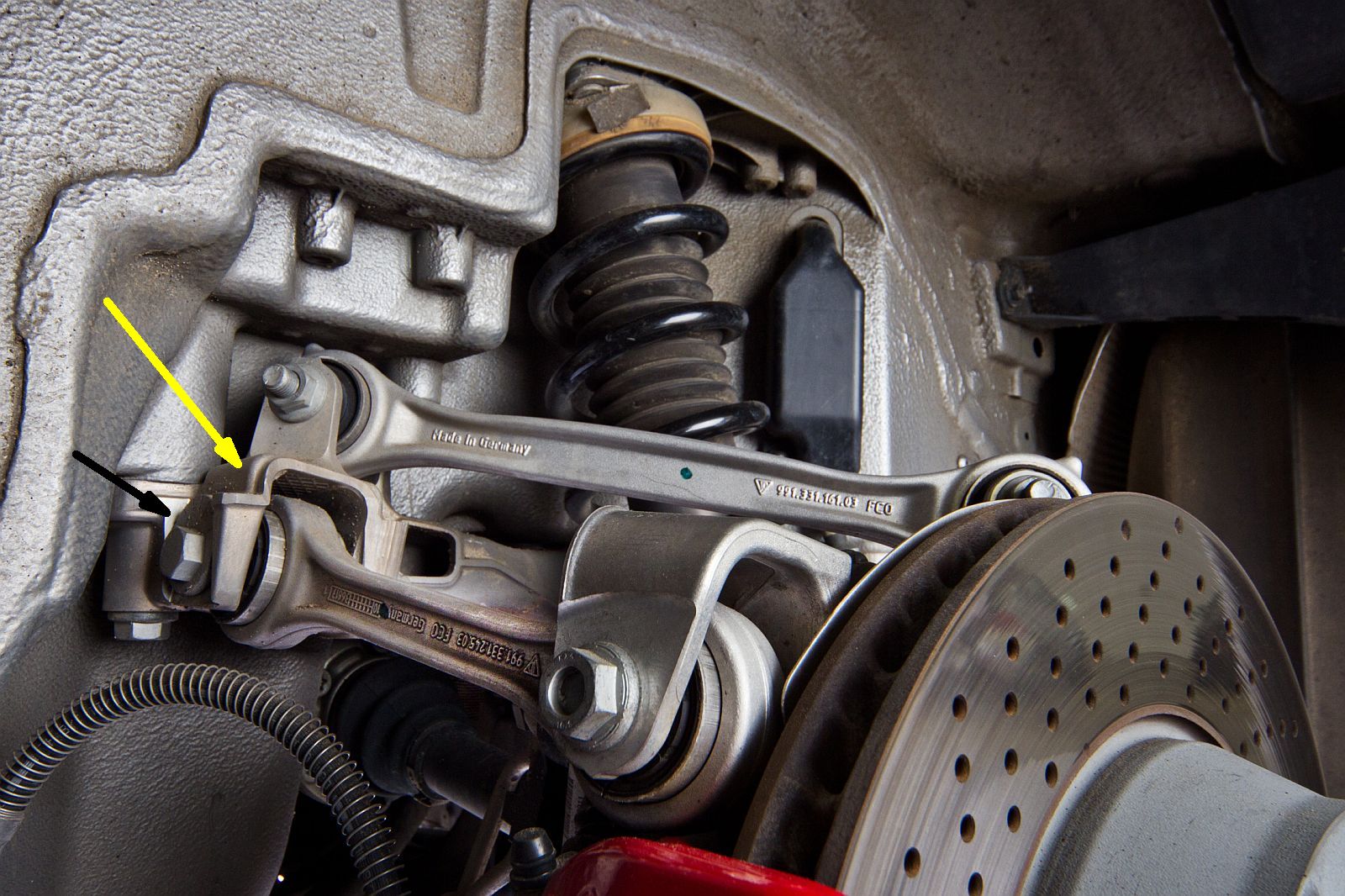
Our trio of upper links attaches to a forged aluminum subframe (yellow) that contains a notch (black) for an eccentric adjusting cam for the toe link.
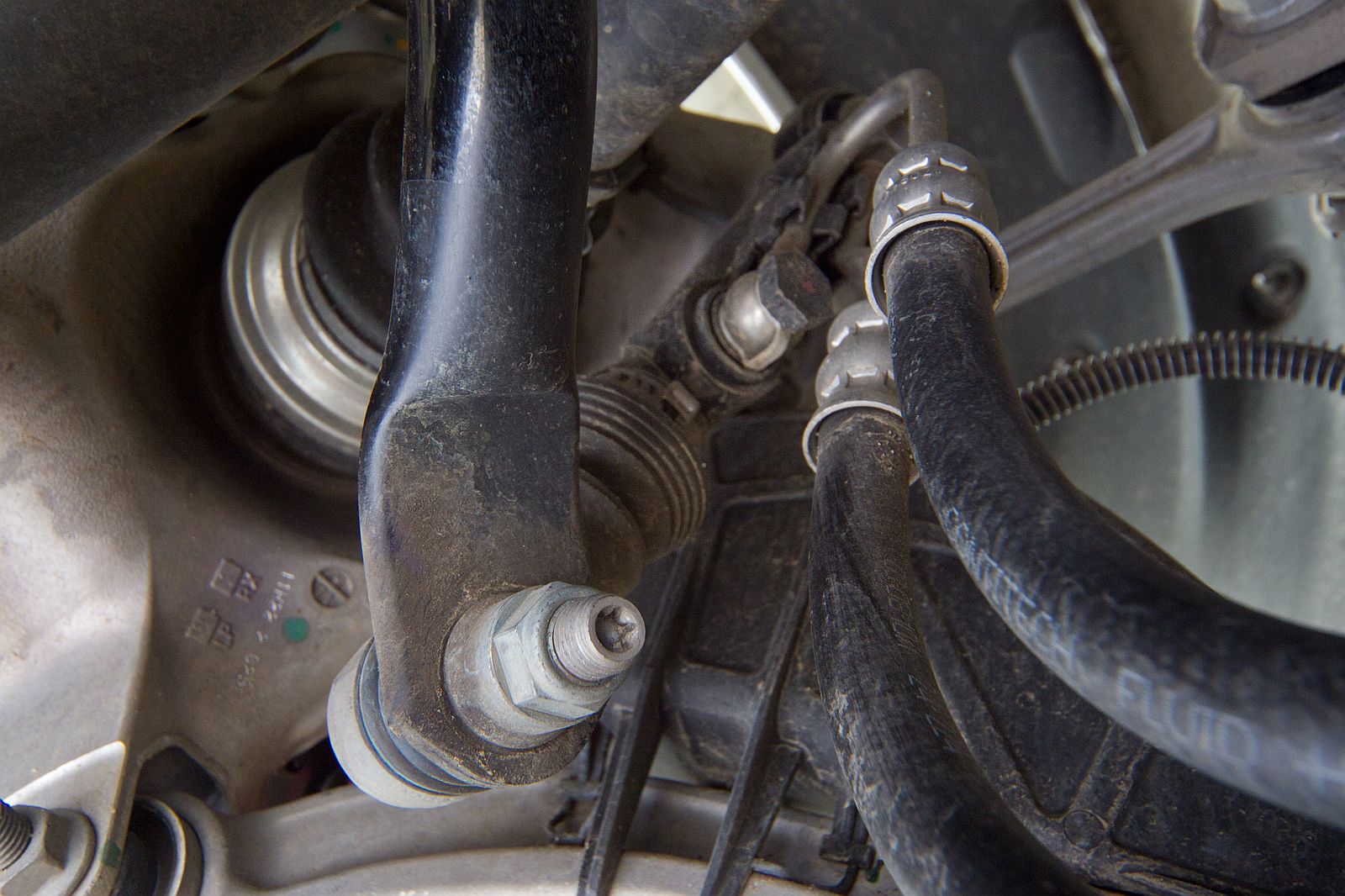
Just like the front, our 991 911's rear stabilizer links are hydraulically controlled by the PDCC system.
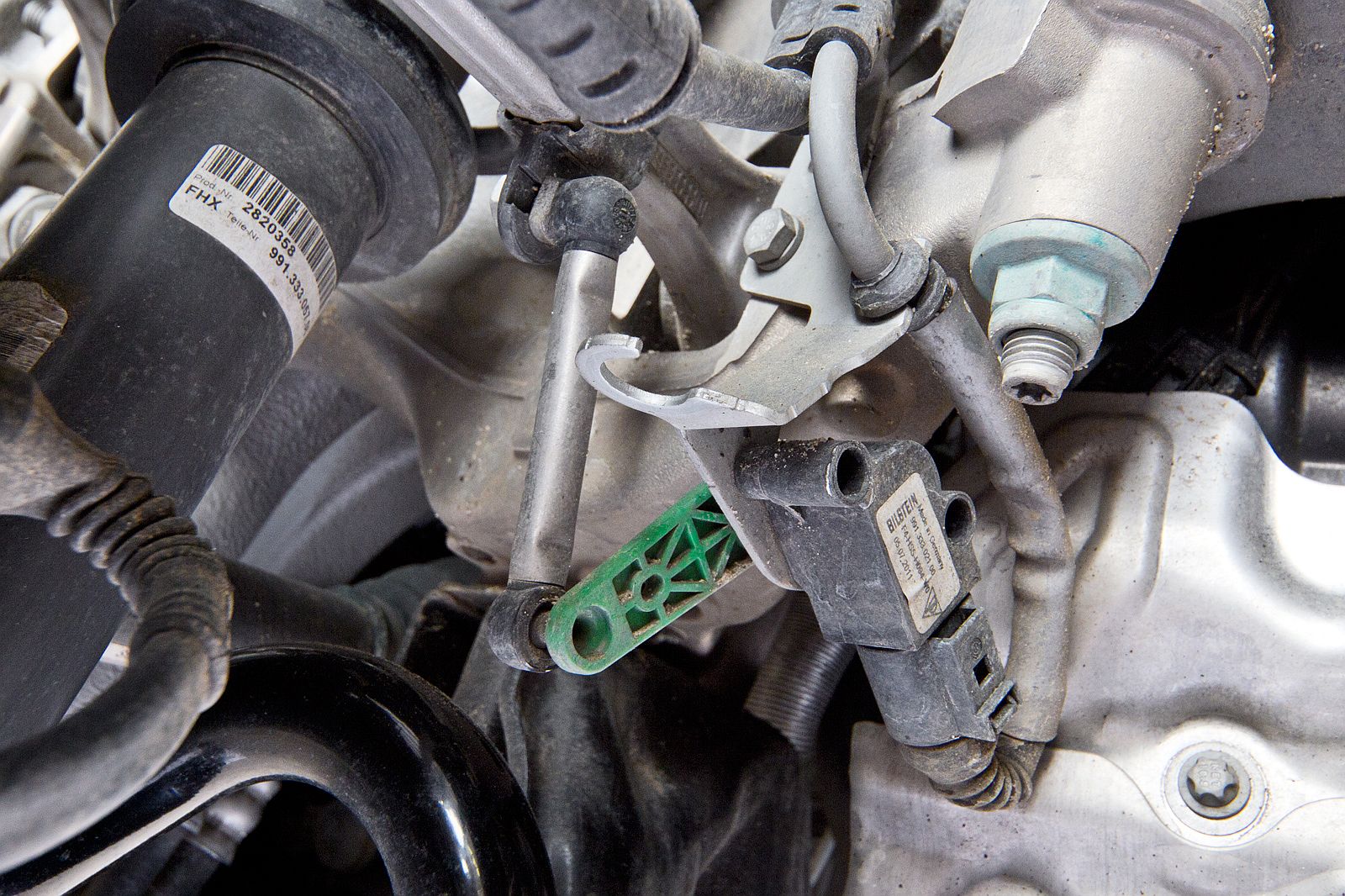
Also like the front, rear height sensors on each side relay the position of the rear suspension to the car's central brain, which in turn shares this data with numerous systems.
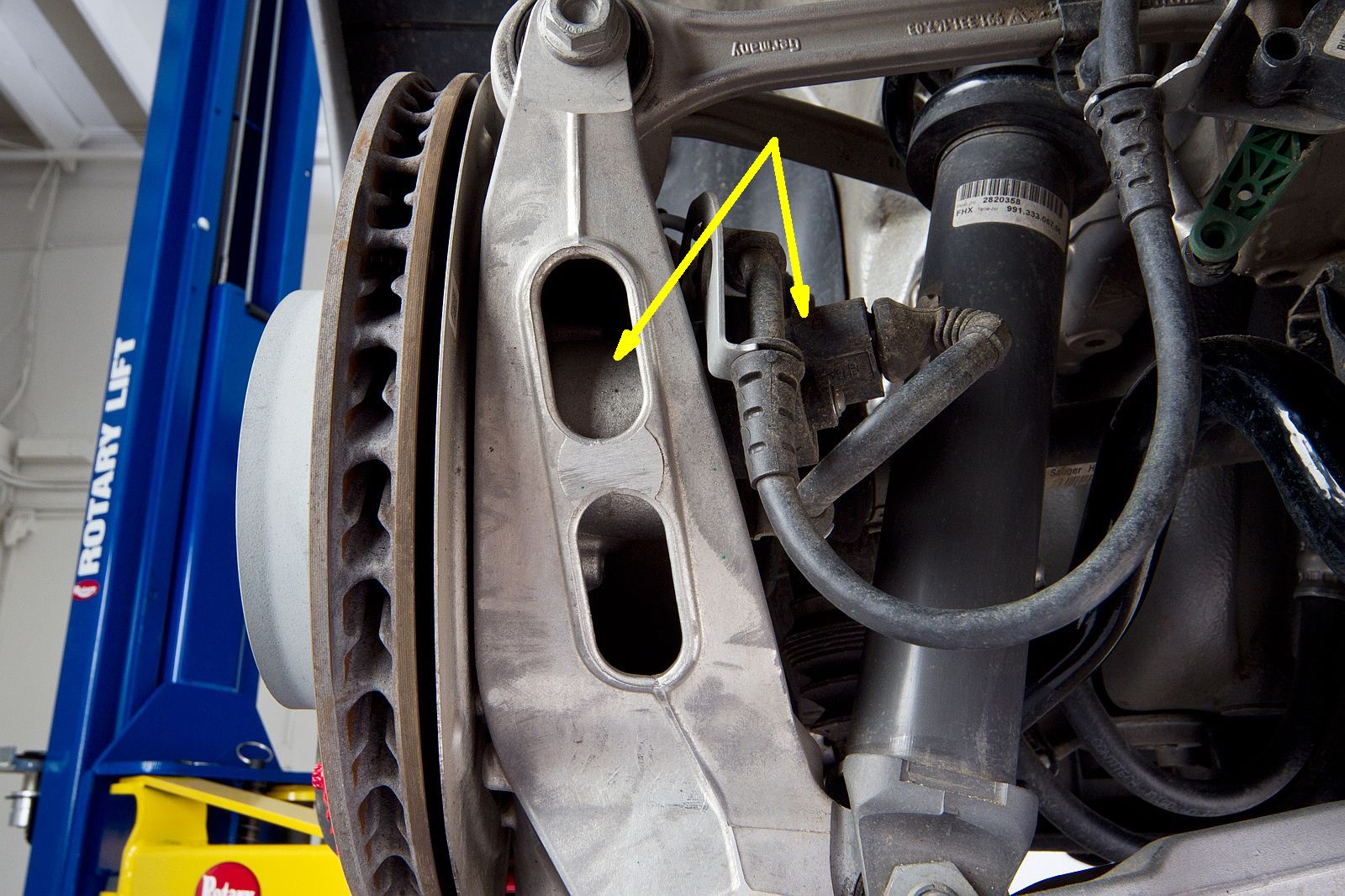
The lightening holes in the rear knuckle allow us to see how the electric parking brake worms itself into the hat section of the rotor, where a drum parking brake lays hidden.
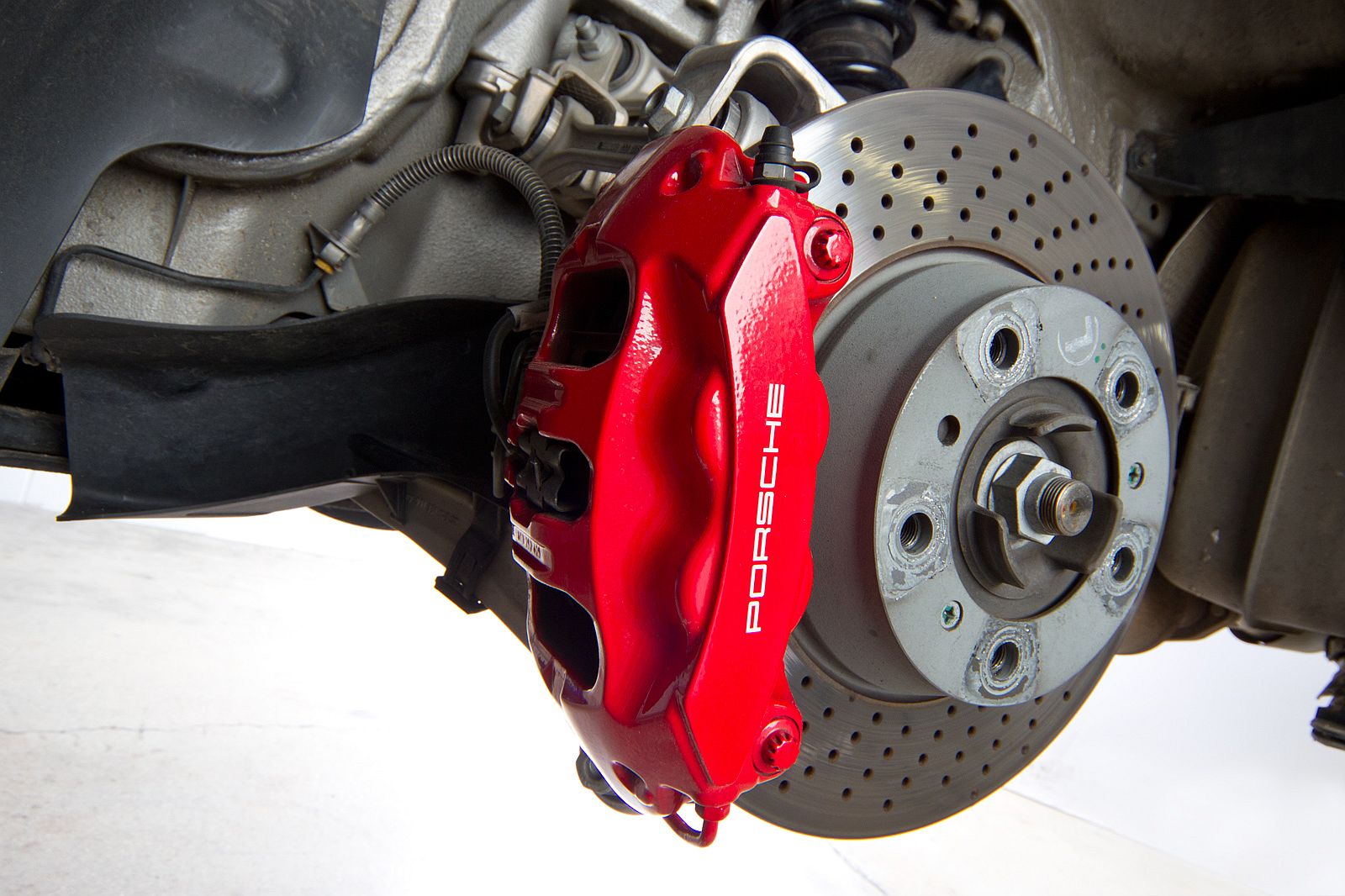
As for the real rear brakes, they're made up of 4-piston fixed-bridge fixed calipers and fully ventilated rotors measuring 13-by-1.1 inches.
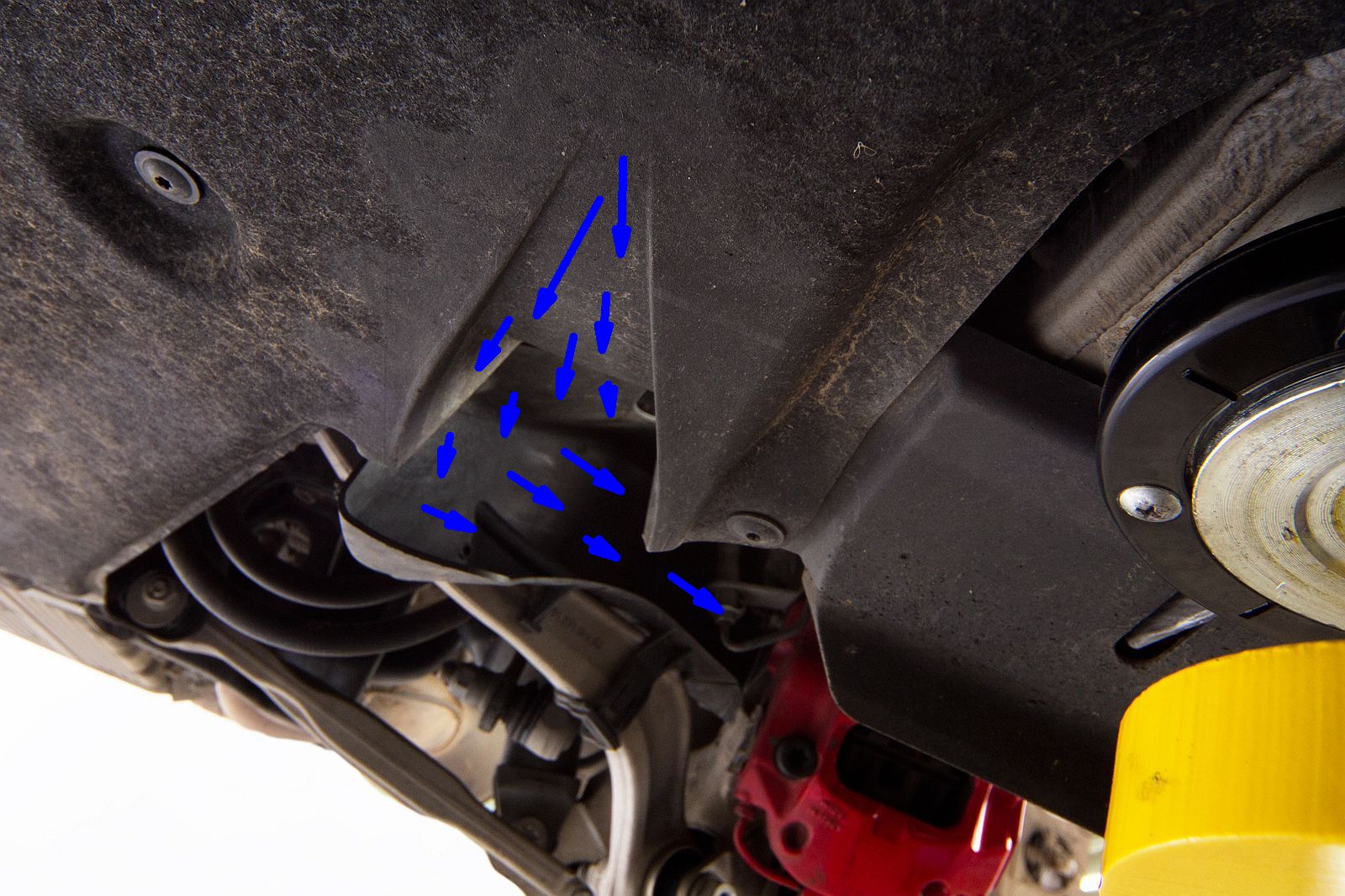
A small NACA duct admits air into ductwork that sends air to the rear calipers.
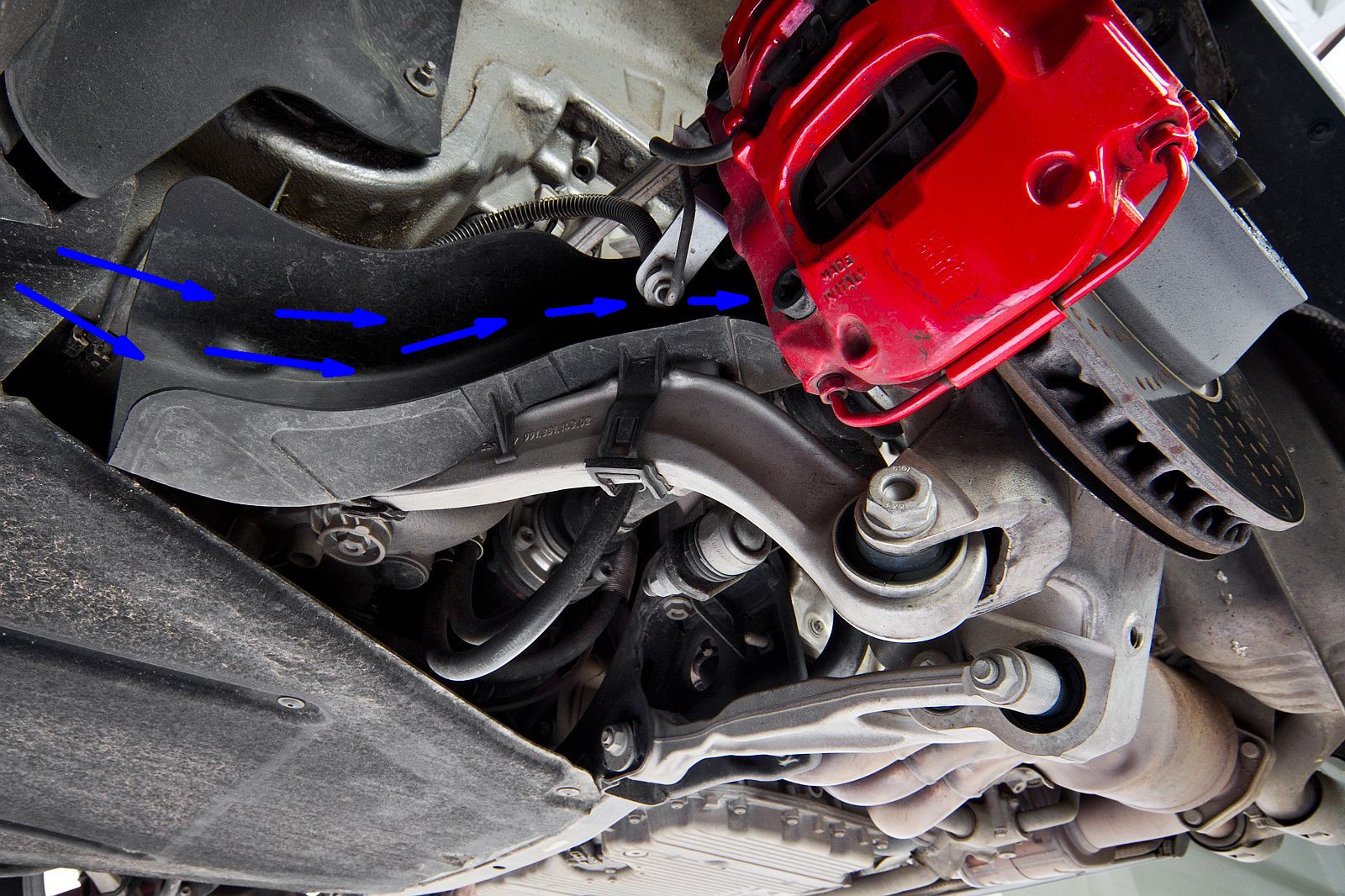
Here's another view of the same ductwork.
All of this rides on massive 20-inch wheels, another 911 first. The fronts measure 20-by-8.5 and are wrapped with 245/35ZR20 rubber, while the rears consist of 20-by-11 wheels and 295/30ZR20 tires. I'd like to tell you how much they weigh all mounted up, but I have not yet equipped our new shop with a suitable scale.
For what it's worth, Porsche claims that the wheels are lighter (than what and by how much they don't say) thanks to a flow-forming process. They also claim the tires have 7 percent less rolling resistance (than last year, presumably) which makes the 1.04 g skidpad number we measured all the more amazing.
By www.Edmunds.com


We thrashed the new 2012 Porsche 911 Carrera S at the track and then we tossed it at some curvaceous mountain roads. Now it's time to give the 911 a much-needed rest and hoist it up on our new Rotary two-post lift for a clear look at the suspension that does the business.
This new 911 is in fact a 991 in the language of Porsche engineering, which is why the 991 prefix appears on the various components we'll soon see. You may also notice a bit of grit and grime under there because the roads were wet much of the time we had it -- except at the track, thank goodness.
Let's get on with it. Here's the 411 on the new 911 suspension.

From here we see what looks like the standard 911 setup: humungous brakes and a MacPherson strut suspension.

A forged aluminum front knuckle (orange) grasps the bottom of the coil-over strut. Like other 911s before it, the 991's steering (yellow) meets it up ahead of the front axle's centerline.
It's electric power steering this time out, but the components are buried beneath covers we don't dare remove. Steering feel earned mixed reviews, but steering accuracy and direct response are as good or better than what we've found in the model it replaces.

The lower control arm is partially hidden by a convoluted bit of ductwork that sends cooling, soothing relief to the brakes.

A lateral link and a tension link come together in a bolted joint to make that lower control arm. Forged aluminum, of course.

As we've seen before, the front stabilizer bar loops over the top of the lower control arm to meet up with the stabilizer link (yellow,) but here that link is something very special, indeed.
Meanwhile, the damper within the strut housing is fitted with PASM (Porsche Active Stability Management,) a continuously variable damping system with two driver-selectable operating ranges, Normal and Sport.

The stabilizer bar link (green) is hydraulic, as is its opposite number on the other side of the car. A central computer looks at body height sensors, steering angle and a host of other factors to determine how to make them behave.
On straight roads they can go limp to essentially remove the stabilizer bar from the picture for a smooth ride. In corners they can be made to "overdrive" what the stabilizer bar could otherwise do on its own to utterly eliminate body roll. Or the computer can dial in any amount of roll stiffness in between, and it can change its mind in real time as road conditions or driver inputs fluctuate.
Porsche calls this Porsche Dynamic Chassis Control (PDCC) and it's the first time they've fit it to a 911-series vehicle. Whatever you call it, it flat works. This very car pulled 1.04 g on our skidpad, and some of the credit has to be put down to the way this system can make use of all four tires instead of leaning heavily on the outside ones.
You could theoretically achieve the same skidpad prowess with a pair of very big stabilizer bars, but then the car would ride like Grade A dog doo. Conversely, a hydraulic anti-roll system such as this doesn't need a physical stabilizer in between the left and right struts at all, but in that case there'd be no fail-safe if the system developed a fault.
As for those looming red brakes, the massive 6-piston Brembo calipers have a pair of fixed bridges (yellow) for maximum caliper stiffness. This means the calipers have to come off when it's time to change the brake pads which, incidentally, are equipped with electronic pad wear sensors.

And now we know what these big hoses (green) are for: they feed hydraulic fluid to the PDCC active stabilizer bar struts.

This sensor, along with three more at the other suspension corners, measures the position of the lower control arm to deduce the position of the tire.
The PDCC system compares the readings to that generated on the other side to measure body roll, and the PASM active damping system uses them to understand the motions of the wheels in order to determine the amount of damping required, be it for ride, cornering, dive/squat, etc. It's likely the headlights use 'em too for auto-leveling.

Here's another look at the 6-piston Brembo calipers. The ventilated and drilled rotors they grip are 13.4 inches in diameter and 1.3 inches thick. This car stopped from 60 mph in 102 feet.

Out back we find a new beautiful-looking multilink suspension.

A sea of forged aluminum surrounds a coil-over monotube shock that naturally contains the same PASM damping internals found up front.

Our new Rotary lift makes it easy to get directly under the car to get a clear view of the 991's two lower links.

The rear shock (and the spring that surrounds it) attaches directly to the rear knuckle for a 1-to-1 motion ratio. Such a ratio demands a long shock absorber, so the lower link employs a fork shape to allow the shock to sit low in the car.
Camber adjustments are made via an eccentric cam on this link's inner end.

Think of the rearmost pair of upper links (yellow) as an approximation of an upper control arm and the forward link (green) as a toe link. Close as they are to the hot brake rotor, their outboard pivot bushings must be made of hardy stuff.
The top of the rear stabilizer bar link (white) is just barely in view, but the fact that it's mounted directly to the rear knuckle means it operates at a 1-to-1 motion ratio.

Our trio of upper links attaches to a forged aluminum subframe (yellow) that contains a notch (black) for an eccentric adjusting cam for the toe link.

Just like the front, our 991 911's rear stabilizer links are hydraulically controlled by the PDCC system.

Also like the front, rear height sensors on each side relay the position of the rear suspension to the car's central brain, which in turn shares this data with numerous systems.

The lightening holes in the rear knuckle allow us to see how the electric parking brake worms itself into the hat section of the rotor, where a drum parking brake lays hidden.

As for the real rear brakes, they're made up of 4-piston fixed-bridge fixed calipers and fully ventilated rotors measuring 13-by-1.1 inches.

A small NACA duct admits air into ductwork that sends air to the rear calipers.

Here's another view of the same ductwork.
All of this rides on massive 20-inch wheels, another 911 first. The fronts measure 20-by-8.5 and are wrapped with 245/35ZR20 rubber, while the rears consist of 20-by-11 wheels and 295/30ZR20 tires. I'd like to tell you how much they weigh all mounted up, but I have not yet equipped our new shop with a suitable scale.
For what it's worth, Porsche claims that the wheels are lighter (than what and by how much they don't say) thanks to a flow-forming process. They also claim the tires have 7 percent less rolling resistance (than last year, presumably) which makes the 1.04 g skidpad number we measured all the more amazing.
By www.Edmunds.com



































